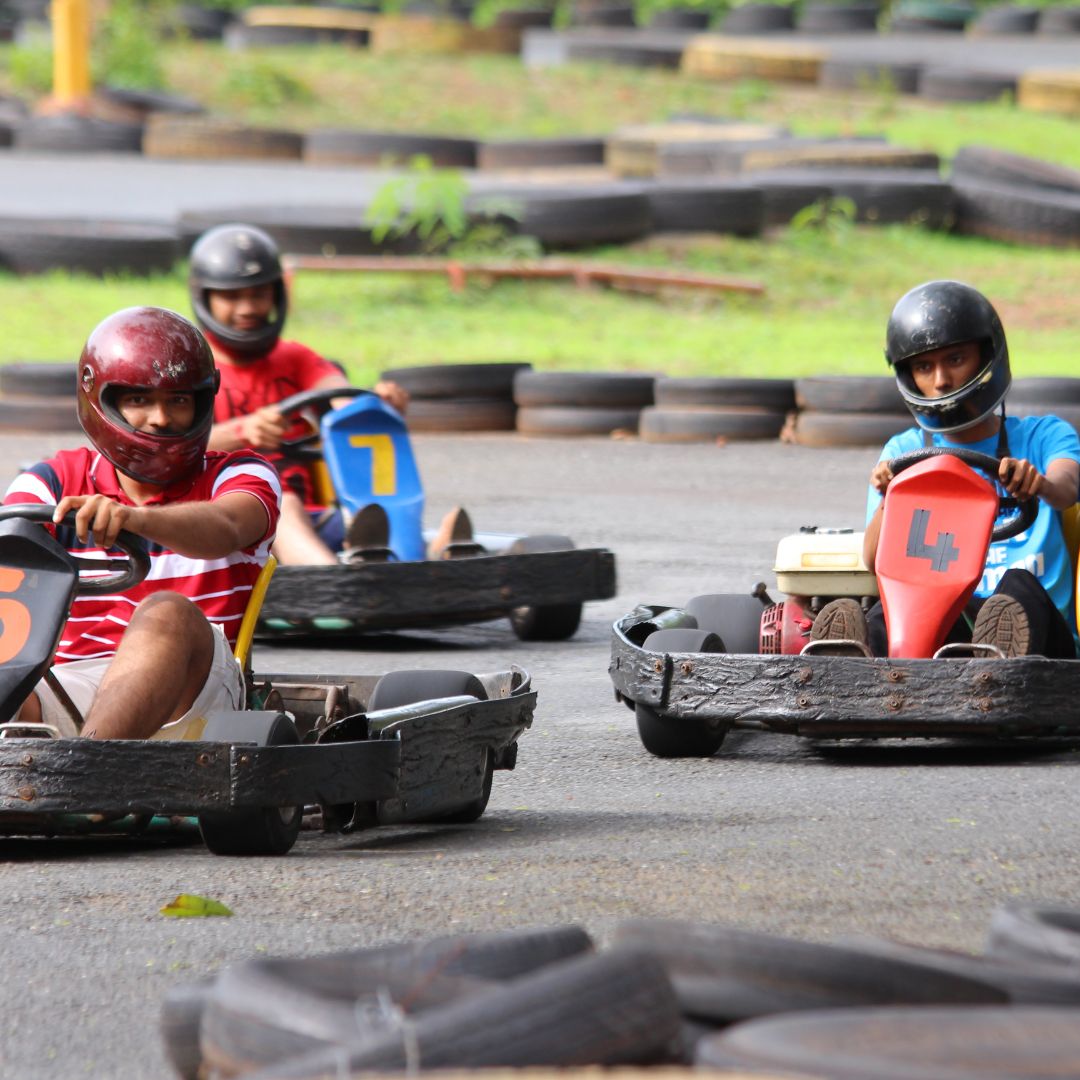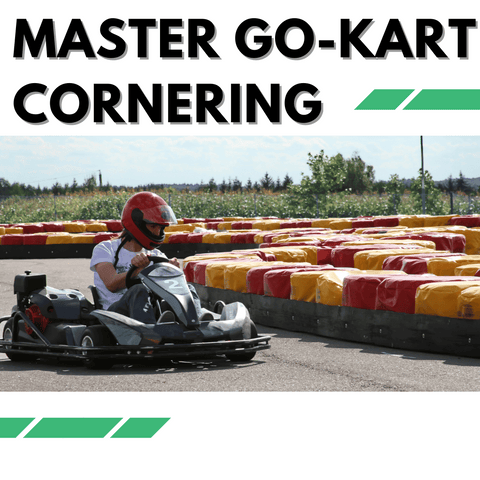
Whether you're new to the thrilling world of go-karting or you're a seasoned racer looking to shave a few seconds off your lap times, you've come to the right place.
Improving your lap times isn't just about pushing the pedal to the metal; it's an art that combines technique, precision, and a bit of science.
So, buckle up as we dive into the essentials of mastering the track in 2024, with a special nod to the latest techniques and innovations in the karting world.
Understanding Racing Techniques
Racing Line: Definition and Optimisation
The racing line is your golden path on the track, the trajectory that minimises your lap time by reducing the overall distance traveled while maintaining the highest possible speed.
To nail this, focus on hitting the apex—the closest point to the inside of the turn—and smoothly transitioning from the entrance to the exit of each curve.
It's like connecting the dots in the most efficient way possible.
Braking Points: Importance and Strategy
Identifying the perfect moment to hit the brakes is crucial. Brake too early, and you lose time; too late, and you might miss the turn entirely.
The trick is to start with conservative braking points and gradually push them closer to the turn as you gain confidence and understand your kart's limits.
Mastering Control and Technique
Smooth Steering: Preventing Understeer/Oversteer
Steering with finesse rather than force is key. Abrupt steering can lead to understeer (where the kart doesn't turn enough) or oversteer (where it turns too much).
Practice smooth, controlled steering movements to keep the kart balanced and responsive.
Acceleration: Controlled Acceleration for Speed
The secret to fast acceleration isn't just flooring the gas pedal; it's knowing when and how much to accelerate.
After turning, gradually increase the throttle as you straighten out, allowing the kart to smoothly gain speed without losing grip.
Enhancing Performance Through Setup
Kart Setup: Adjusting for Track Conditions
Your kart must be a chameleon, adapting to different track conditions.
This includes adjusting tyre pressure, alignment, and weight distribution based on the track's layout and weather.
Staying ahead of the game means being willing to tinker and test until you find the perfect setup.
Tyre Selection and Management
Choosing the right tyres for your kart isn't just about picking the stickiest compound available.
It's about understanding the track conditions, temperature, and how different compounds perform over time.
Regularly check your tyres for wear and pressure to ensure they're in prime condition.
Proper tyre management means you're not just fast for one lap; you're consistently fast for the entire race.
Weather Adaptation Strategies
Racing isn't always under the perfect sunny sky. When the weather turns, your ability to quickly adapt your kart setup and racing strategy can make all the difference.
Wet conditions may require different tyres, altered suspension settings, and a more cautious approach to braking and cornering.
Learning to read the weather and preemptively adjust can give you an edge over those who wait until the last minute.
Step-by-Step Summary to Improve Lap Times
| Step | Detailed Action |
|---|---|
| 1 | Optimise Racing Lines: Focus on the ideal path around the track to minimise distance and maintain high speeds through corners. |
| 2 | Master Braking Points: Identify the optimal points to begin braking for corners, balancing speed and control to prevent overshooting. |
| 3 | Control Steering and Acceleration: Utilise smooth steering techniques and controlled acceleration to maintain traction and speed. |
| 4 | Kart Setup Adjustments: Tweak your kart's settings based on track specifics and conditions to optimise performance. |
| 5 | Optimise Body Positioning: Adjust your seating and weight distribution to enhance kart balance and handling through turns. |
| 6 | Physical and Mental Preparation: Engage in physical fitness and mental strategies to improve focus, endurance, and performance. |
| 7 | Analyse Performance Data: Use telemetry and other data to review and refine your racing technique for continuous improvement. |
Personal Performance Factors
Body Positioning: Impact on Kart Balance
Your body is an extension of the kart. Lean into turns, adjust your seating position for optimal weight distribution, and stay relaxed.
A tense driver is a slow driver, so breathe and let the kart flow with the track.
Consistency: Maintaining Stable Lap Times
Consistency is king. It's better to have stable lap times than a single fast lap followed by several slower ones.
Focus on repeating your lines, braking points, and acceleration patterns to build muscle memory and reliability.
Nutrition for Racers
What you put into your body before a race can be as important as the fuel you put in your kart.
A balanced meal rich in carbohydrates for energy, moderate in proteins for muscle repair, and low in fats for quick digestion is ideal.
Staying hydrated is crucial, too, as even mild dehydration can impair reaction times and decision-making abilities.
Mental and Physical Preparation
Fitness and Endurance: Improving Performance
Karting is physically demanding. Improve your core strength, flexibility, and endurance to withstand the rigors of racing.
A fit driver can maintain focus and performance for longer periods, giving them an edge in longer races.
The Role of Simulators in Training
While there's no perfect substitute for actual seat time in a kart, simulators have come a long way in preparing racers for the real thing.
They offer the opportunity to learn tracks, understand racing lines, and refine braking techniques without the wear and tear on your body or kart.
Regular sessions on a simulator can enhance your spatial awareness and racecraft, especially when practising tracks you've never physically driven on.
Mental Preparation: Focus, Visualisation, and Pressure Management
Racing is as much a mental game as a physical one. Practice visualisation techniques to mentally walk through the track, anticipating turns, braking points, and overtaking opportunities.
Managing pressure and staying focused can make the difference between a good lap and a great one.
Analysing Data and Racing Etiquette
Data Analysis: Telemetry Data for Improvement
Welcome to the future of racing. Use telemetry data to analyse your performance, identifying areas for improvement.
Today's karts come equipped with sensors that track speed, acceleration, and more, offering insights that were once available only to professional racers.
Racing Etiquette: Fair Play and Rule Understanding
Last but not least, respect your fellow racers and the rules of the track.
Good sportsmanship ensures everyone has a great time and competitions remain fair and enjoyable.
Constructive Post-Race Analysis
After the adrenaline fades, take the time to analyse your performance.
Whether it's reviewing telemetry data, discussing strategies with your team, or simply reflecting on your race decisions, every session offers valuable lessons.
What worked well?
What could be improved?
This introspective approach ensures that every lap around the track, every race, brings you one step closer to your best performance.
Advanced Techniques and Innovations
As we race into 2024, let's dive into the latest innovations in electric go-karts and training technologies that are reshaping the landscape of kart racing.
Electric Go-Kart Innovations
-
Brushless DC Motors: A leap forward in motor technology, brushless DC motors are at the heart of this revolution. These motors outshine their brushed counterparts by offering superior torque and speed, which translates into breathtaking acceleration and a marked improvement in overall performance. The efficiency and reliability of brushless motors mean racers can expect a smoother ride with less downtime for maintenance.
-
Advanced Battery Technology: The fuel powering these electrifying rides is none other than the latest in lithium-ion battery technology. These batteries are a game-changer, offering longer life spans, faster charging, and the kind of high-powered energy needed to sustain the demands of intense racing. The advent of lithium iron phosphate (LFP) batteries in models like the ECOVOLT NG+ enhances performance further, providing a robust, efficient power source that keeps karts running faster and longer.
-
High Performance and Handling: The design of electric go-karts, with their evenly-distributed weight and near-instant torque delivery, ensures a level of acceleration and handling that gas-powered karts can only dream of. This not only allows for rapid acceleration to top speeds but also offers a handling advantage in tight corners and complex track layouts.
-
Eco-Friendly Racing: Beyond the track, electric go-karts are winning races in sustainability. Silent yet powerful, these karts produce zero emissions, offering a cleaner, greener alternative to traditional karting. This shift is significant, reducing the sport's environmental impact and making the thrill of racing accessible in more places, including indoor tracks where noise and pollution are concerns.
-
Record-Breaking Speeds: Demonstrating the potential of electric propulsion, Blue Shock Race set a breathtaking new benchmark with a production electric go-kart reaching speeds of 163 km/h (101.3 mph). This feat not only showcases the incredible performance capabilities of electric karts but also highlights the ongoing advancements in electric drivetrain technology.
Training Technologies: AR and VR
Augmented reality (AR) and virtual reality (VR) technologies are transforming the way racers train, offering immersive experiences that replicate the physical sensations and challenges of real-world racing.
Through AR and VR, racers can:
- Experience tracks virtually, learning every turn, bump, and straightaway with precise detail before setting foot on the actual circuit.
- Engage in simulated races that hone reaction times, strategy, and technique in a risk-free environment, allowing for experimentation and learning without the physical and financial constraints of traditional training.
- Benefit from real-time feedback and data analysis, improving their skills through a tailored, interactive learning process.
FAQs
What are the most effective ways to mentally prepare before a go-kart race to improve lap times?
Mental preparation is just as crucial as physical readiness when aiming to improve your go-kart lap times. Visualization techniques, where you mentally rehearse a race, imagining each turn and straightaway, can significantly enhance your performance by making you feel more prepared and reducing anxiety. Additionally, setting realistic goals for each session can help maintain focus and motivation. Deep breathing exercises or listening to music can also calm nerves and improve concentration right before hitting the track.
How can analyzing competitors' racing styles and lap times benefit my own performance?
Studying your competitors is a strategic way to enhance your own racing performance. Pay attention to their racing lines, braking points, and how they handle various sections of the track. This can offer insights into different approaches to the same corners or sequences, potentially revealing faster or more efficient techniques that you haven't considered. Also, understanding the strengths and weaknesses of other racers can help you identify opportunities to overtake or defend your position during a race.
Are there specific exercises or training routines that can improve my performance in go-kart racing?
Yes, specific physical exercises can boost your performance in go-kart racing. Focus on building core strength, as a strong core improves your ability to maintain control of the kart, especially through tight corners. Cardiovascular fitness is also important, as it increases endurance, allowing you to maintain high performance throughout longer races. Exercises like planks, sit-ups, squats, and lunges are great for core strength while cycling, running, or swimming can improve your cardiovascular health. Hand-eye coordination exercises, such as playing catch or video games, can also sharpen your reflexes, contributing to better racing decisions.
Get in Touch 🚀
Loved our article on “How to Improve Go Karting Lap Times” Got the itch to dive into more wheely-awesome info?
Whether you're a parent or a grandparent, we're here for all your kids ride-on toy questions! 🚗💨
Feeling click-happy?
Jump straight into our wonderland at RiiRoo.com.
Or, if you're more the chatty type, give our Live Chat a whirl and let's talk toys!










Share:
Here's Why You Should Buy a Kids Drift Go Kart
5 Things Your Kids Should NEVER do on a Quad Bike